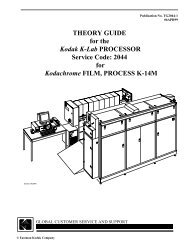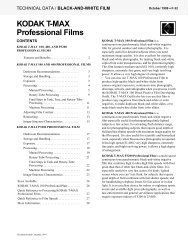KODAK PROFESSIONAL ENDURA Metallic Paper - 125px
KODAK PROFESSIONAL ENDURA Metallic Paper - 125px
KODAK PROFESSIONAL ENDURA Metallic Paper - 125px
You also want an ePaper? Increase the reach of your titles
YUMPU automatically turns print PDFs into web optimized ePapers that Google loves.
PROCESS CONTROL<br />
To produce high-quality color prints consistently and with a<br />
minimum of waste, you need to match your process to a<br />
standard for density, color, and contrast each time you<br />
process paper. In addition to monitoring process parameters<br />
such as solution times, temperature, replenishment rates,<br />
solution concentrations, etc., you should regularly run<br />
control strips to ensure best results.<br />
<strong>KODAK</strong> <strong>PROFESSIONAL</strong> Pro Strips Color Negative<br />
<strong>Paper</strong> Control Strips / for Process RA-4 (CAT 129 8587) are<br />
designed specifically for use with <strong>KODAK</strong><br />
<strong>PROFESSIONAL</strong> <strong>Paper</strong>s and <strong>KODAK</strong> <strong>PROFESSIONAL</strong><br />
Print and Display Materials in professional labs. These<br />
control strips are designed to detect process conditions that<br />
can degrade the quality of your finished prints. They are<br />
better able to track the papers that are processed in<br />
professional finishing laboratories.<br />
For more information, see <strong>KODAK</strong> Publication No.<br />
CIS-202, Using <strong>KODAK</strong> <strong>PROFESSIONAL</strong> Pro Strips<br />
Color Negative <strong>Paper</strong> Control Strips / for Process RA-4.<br />
SCANNER TOOLS<br />
The <strong>KODAK</strong> Q-60 Color Input Targets are available on<br />
<strong>KODAK</strong> EKTACHROME Professional Film in both 35 mm<br />
and 4 x 5 inch formats and on <strong>KODAK</strong> EKTACOLOR <strong>Paper</strong>.<br />
Developed primarily for use by prepress houses in the<br />
printing industry, this target can also be used by professional<br />
photographers, desktop publishers, and in the emerging<br />
hybrid imaging area.<br />
The target is designed for use in the commercial and<br />
desktop arenas as a comparative control tool to help<br />
customers calibrate their input product to the final output.<br />
This target maps the gamut of color space that <strong>KODAK</strong><br />
EKTACHROME Film and EKTACOLOR <strong>Paper</strong> can<br />
reproduce.<br />
When used properly, customers will be able to compare<br />
their output—whether it is separations for the printed page<br />
and four-color printing, or second-generation originals from<br />
a film recorder to the originals. This will help customers<br />
optimize the capabilities of their system for color<br />
reproduction of an extreme range of color gamut.<br />
Scanner color characterization targets produced in<br />
accordance with ANSI IT8.7/1 (transmission) and IT8.7/2<br />
(reflection) Standards (or ISO 12641) are available from<br />
Kodak.<br />
The <strong>KODAK</strong> <strong>PROFESSIONAL</strong> Q-60 Color Input<br />
Target ⁄ Q-60R2 is manufactured on <strong>KODAK</strong><br />
<strong>PROFESSIONAL</strong> <strong>ENDURA</strong> <strong>Paper</strong>, and is likewise<br />
identified by a watermark with a single grey dot under<br />
PAPER. This target can be used with both the newer<br />
<strong>ENDURA</strong> <strong>Paper</strong>s and older papers. The older Q-60R1<br />
target, which has the same two-dot watermark as the older<br />
papers, can be used with the newer papers.<br />
ILLUMINATION FOR EVALUATION OF<br />
PRINTS<br />
Evaluation of prints for color and density requires higher<br />
illumination levels than those used in normal display<br />
conditions. A good average condition is a light source with<br />
a color temperature of 5000 K ± 1000, a Color Rendering<br />
Index of 85 to 100, and an illuminance of at least 50<br />
footcandles (538 lux). Fluorescent lamps such as cool white<br />
deluxe (made by several manufacturers) meet these<br />
conditions.<br />
You can also use a mixture of incandescent and<br />
fluorescent lamps. For each pair of 40-watt cool white<br />
deluxe fluorescent lamps, use a 75-watt frosted, tungsten<br />
bulb.<br />
Viewing conditions should meet ANSI Standard<br />
PH2.30-1989.<br />
RETOUCHING<br />
If possible, do any required retouching on color negatives<br />
before you make prints—especially if you plan to make more<br />
than one print from each negative. For information on<br />
retouching negatives, see <strong>KODAK</strong> Publication No. E-71,<br />
Retouching Color Negatives.<br />
If the negative image is small, you can make corrections<br />
much more easily by applying dry or liquid dyes to small or<br />
large areas of the enlarged print. Although you’ll probably<br />
do most retouching with dyes, you may sometimes want to<br />
use black lead, colored pencils, or opaque. Because color<br />
prints have separate dye layers, you can’t use an etching<br />
knife to reduce density as you can with black-and-white<br />
materials. For information on retouching prints, see<br />
<strong>KODAK</strong> Publication No. E-70, Retouching Prints on<br />
<strong>KODAK</strong> EKTACOLOR and EKTACHROME <strong>Paper</strong>s.<br />
<strong>KODAK</strong> <strong>PROFESSIONAL</strong> <strong>ENDURA</strong> <strong>Metallic</strong> <strong>Paper</strong> • E-4028 5

















